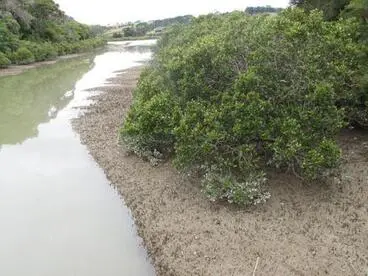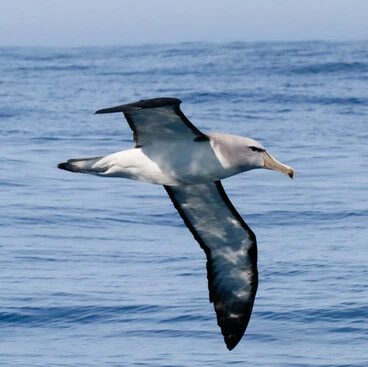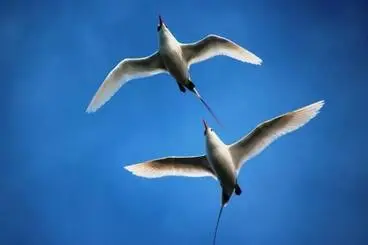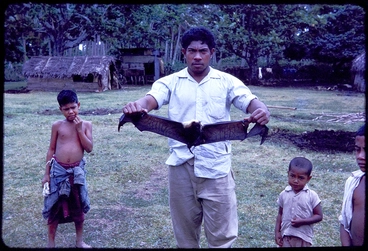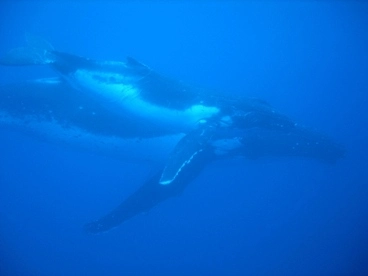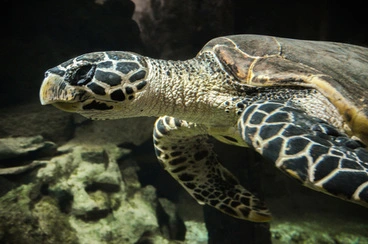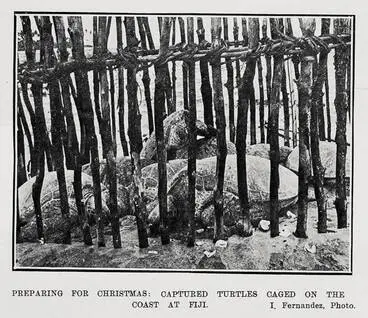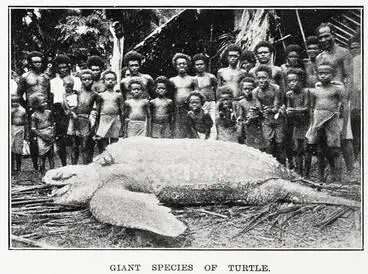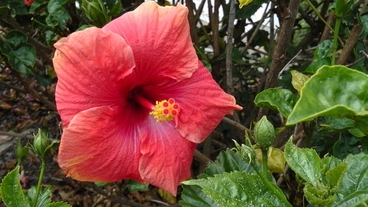Pacific Flora and Fauna
A DigitalNZ Story by National Library Services to Schools
Covering a huge area, the Pacific is home to plants and animals that have adapted to new habitats as they spread east across the ocean from Southeast Asia.
BACKGROUND
Many of the plants (flora) and animals (fauna) on the islands of the Pacific are unique. Some arrived on the islands with the first settlers, others by sea or were carried by wind or birds. These species were forced to adapt to new environments on islands and atolls, often in isolation, creating a huge range of new species. Many are found nowhere else in the world.
This story introduces some of these interesting species and includes information about the following:
- Coconut & pandanus
- Food crops
- Paper mulberry
- Mangrove
- Birds of the land
- Seabirds
- Reptiles & bats
- Whales
- Sea turtles
- Coconut crabs
- Glossary
- Supporting resources.
Frangipani is a plant synonymous with the Pacific.
Museum of New Zealand Te Papa Tongarewa
FLORA
COCONUT AND PANDANUS
Two trees of significance in the Pacific are coconut and pandanus. Both have a multitude of uses and are an integral part of life on the Pacific islands.
QUICK FACTS
- Coconuts are believed to have spread across the Pacific from Southeast Asia by sea, floating on ocean currents. They were also transported by the first settlers.
- Almost every part of the coconut is used; the flesh of the shell and its water as food, the dried shell for containers, the leaves for constructing shelter and for weaving, the oil for cooking, the fibre for rope making, and the wood for building houses and canoes.
- A traditional drink is also made from the sweet sap gathered from new fronds at the top of the coconut tree.
- Leaves of the pandanus are put to good use in weaving and thatching, the wood is used for building, scented oils are made from the bark and roots, which are also used for traditional medicines and rope making.
- The people of Kiribati call the pandanus the 'tree of life' because of its usefulness in everyday life.
- Dried pandanus was an important source of food for long canoe voyages.
Coconut shell container
Museum of New Zealand Te Papa Tongarewa
Pandanus Tree - Tongatabu [Tongatapu]
Museum of New Zealand Te Papa Tongarewa
Pandanus basket
Museum of New Zealand Te Papa Tongarewa
FOOD CROPS
Several staple food crops were grown with varying degrees of success throughout the Pacific and formed an important part of the diet for most people. Except for the kumara, they were all introduced by the people who populated the Pacific from Southeast Asia. They were:
- kumara (sweet potato)
- hue (bottle gourd)
- taro
- yam
- Pacific cabbage tree
Three varieties of kumara bought to New Zealand from the Pacific.
Manatū Taonga, the Ministry for Culture and Heritage
QUICK FACTS
- Kumara, a minor crop on most islands, originated in South America and is the only crop cultivated in the Pacific that did not come from Asia.
- Grown primarily for their fruit, hue or bottle gourds were also used as containers.
- The tuber of taro was an important food source. A crop that requires lots of water, irrigation systems were often devised.
- Yams are also a root crop, and are known as u'i in the Cook Islands, ufi in Samoa, uvi in Fiji and mami in Papua New Guinea.
- The taproot of the cabbage tree was edible once it was beaten and steamed. Also eaten was the stem pith and central shoot.
Hue – gourd
Manatū Taonga, the Ministry for Culture and Heritage
Taro Plantation
Museum of New Zealand Te Papa Tongarewa
Oxalis tuberosa - yam or oca 2
Lincoln University
PAPER MULBERRY
The paper mulberry thrives throughout the Pacific Islands and its bark was invaluable for the production of tapa cloth. Tapa was used not only for clothing and mats but was significant culturally in most island groups, often used in ceremonies.
Paper Mulberry, the raw material for tapa cloth.
Manatū Taonga, the Ministry for Culture and Heritage
QUICK FACTS
Tapa cloth is made from the inner bark of the Paper Mulberry tree. Although the process varied between islands the basic steps were as follows:
- narrow strips of bark are soaked in water
- strips are beaten with a wooden mallet on an anvil to soften the fibres and flatten the pieces
- strips are folded and beaten again
- the strips are then joined together through further beating to make large pieces
In some islands, the bark of fig and breadfruit trees were also used to make cloth. Surface patterns on tapa are distinct to different island groups. For example, in Fiji, where tapa is called masi, the patterns are strongly geometric and painted in black and brown on the white/cream coloured cloth. In the Cook Islands tapa was used for ceremonial masks, worn by both men and women.
Tappa Making
Auckland War Memorial Museum Tāmaki Paenga Hira
Masi Bolabola
Auckland War Memorial Museum Tāmaki Paenga Hira
mask
Auckland War Memorial Museum Tāmaki Paenga Hira
MANGROVE
Mangroves are most prolific in Papua New Guinea, the Solomon Islands, Fiji and New Caledonia. There are 34 different species, covering an area of over 343,000 ha.
Mangroves are important in the Pacific Islands as the wood is used for building, traditional medicine, and as fuel for fires. Areas where mangroves grow are vital fish and shellfish gathering and also provide habitat for growing fish as well as birds.
QUICK FACTS
- The mangrove has made special adaptations to survive in the inter-tidal zone where the water is very salty, there are low levels of oxygen and very few nutrients.
- Part of the success of the mangrove is that it produces seeds which can survive floating on the surface of the ocean for long periods of time before finding land and putting down roots.
- Dyes can be extracted from mangroves that are used to treat textiles, nets and fish traps.
- Mangroves filter water and therefore reduce pollution from the land to the sea.
- Important in combating erosion caused by rising sea levels, mangroves are actively being replanted throughout the Pacific.
- Mangroves are also a tool in the battle against climate change because they can store two to four times more carbon from the atmosphere than most tropical plants.
Mangrove
iNaturalist NZ — Mātaki Taiao
Mangrove swamp - Regi - Ysabel - Solomons
Auckland War Memorial Museum Tāmaki Paenga Hira
FAUNA
BIRDS OF THE LAND
Birds in the Pacific often evolved on islands without predators or competition for food sources.
On islands devoid of large mammals, they were valuable sources of food for people (meat and eggs), and their feathers were prized for clothing and ornamentation for chiefs and high ranking people. Feather-covered objects were also used for a wide range of ceremonial purposes.
Different cultures throughout the Pacific had preferences for different feathers, sometimes because of distinctive or significant colour or shape, and sometimes because of symbolism associated with a particular bird's behaviour.
The honeycreeper was prized in Hawaii for it's brightly coloured feathers.
Museum of New Zealand Te Papa Tongarewa
QUICK FACTS
- The brilliant red feathers of the scarlet honeycreeper of Hawaii were particularly highly prized. The helmet below belonged to high chief Kalani`ōpu`u before he gifted it to Captain Cook on his third visit to the islands. Between 500,000 and 800,000 individual feathers were used to make this cloak.
- It is believed that each village in the Hawaiian island group had a person trained in gathering feathers. To obtain the feathers, the birds were not killed, rather 2-3 feathers were plucked from each bird and they were then released.
- Today the scarlet honeycreeper is endangered in Hawaii and is restricted to small patches of habitat on just three islands. Originally there were 50 species of these birds thriving on the islands, however, this has declined to 17 in recent times.
- In Tonga, parrot feathers represented status, and the most prized were the red feathers from the Fijian kaka. Tongans would trade tabua (whale's teeth), ngatu (decorated tapa) or fine mats from Samoa with Fijians for these prized feathers.
- In Santa Cruz, long belts were made from the feathers of honeyeater birds and used as a form of money; each belt would require approximately 300 feathers.
‘Ahu‘ula
Auckland War Memorial Museum Tāmaki Paenga Hira
Mahiole (feathered helmet)
Museum of New Zealand Te Papa Tongarewa
Tevau (red feather currency)
Museum of New Zealand Te Papa Tongarewa
SEABIRDS
Sea birds, known as pelagic birds by ornithologists, are birds that spend most of their time at sea and only come to land to nest.
The Pacific is home to the most diverse populations of sea birds on Earth, however, they are also more threatened than any other type of bird.
These birds were particularly important for those trained in the art of navigation. Navigators would be familiar with the territories, behaviours and migratory paths of birds, along with the time of year migration would occur. They used this information to help guide them during voyages between island groups.
Several species of albatross are seen in the Pacific.
iNaturalist NZ — Mātaki Taiao
QUICK FACTS
- Well known sea birds found in various parts of the Pacific include species of Albatross, Frigate bird, Tropic bird, Tern and Petrel.
- Sea birds are incredible flyers and aerial acrobats. They can be found thousands of kilometres from land.
- Albatross have immense wingspans, the largest reaching over 3 m, which allow them to glide and fly across vast expanses of the ocean with little effort.
- Like some other species of sea bird, albatross drink seawater.
- Frigate birds are culturally significant across the Pacific and considered sacred in many cultures due to their importance to navigation. Stylised motifs were commonly found on ornamental and ceremonial objects.
- Birds in the petrel family have declined in the Pacific more than any other species. Once thought to have become extinct, it is estimated that less than 50 pairs of Fiji Petrel (iconic in those islands) survive today.
Northern Giant Petrel
iNaturalist NZ — Mātaki Taiao
Red-tailed Tropicbird
iNaturalist NZ — Mātaki Taiao
REPTILES AND BATS
When people first arrived in the Pacific, there were few other land animals other than lizards and bats. Along with birds, these two species were easy prey, and many bats and larger lizard species became extinct shortly after human occupation.
Those that survived around the region have struggled and many are now in decline due to the continuation of traditional hunting, changing climatic conditions, loss of habitat and predation by introduced pests.
Evidence of Giant Iguana were found in Fiji.
Manatū Taonga, the Ministry for Culture and Heritage
QUICK FACTS
- 3,000-year-old fossils of an extinct giant iguana, estimated at half a meter long, were found in Fiji on the island of Viti Levu.
- It was originally thought that lizards colonised Pacific islands 'by accident', hitching rides on driftwood and plant matter, however, the latest theory is that they began colonising the Pacific by simply walking across the land when the islands were part of the supercontinent Gondwana.
- The Pacific is home to 31% of the bat species on Earth and has the biggest and most unique bats on the planet.
- Tahiti has no bat species, however, there are 6 in Fiji and over 40 in the Solomon Islands.
- Another name for bats in the Pacific is flying fox, and they were often the only native mammal on island habitats, acting as important distributors of seeds.
- Scientists estimate that 70 of the Pacific's bat species are threatened, and deforestation for agriculture is a significant factor in their decline.
drum
Auckland War Memorial Museum Tāmaki Paenga Hira
Flying Fox
Auckland Libraries
WHALES
Whales hold many records in the animal kingdom. The blue whale is the biggest animal that has ever lived, and the sperm whale has the largest brain. The humpback’s flippers are the largest limbs of any animal, and it also sings the longest songs.
Source: Whales, Te Ara - the Encyclopedia of New Zealand
QUICK FACTS
- Whales are part of the group known as cetaceans, which includes dolphins and porpoises, and they are also mammals.
- The Pacific Ocean is home to almost half the species of whales on Earth.
- There are two groups of whales, toothed whales and baleen whales that do not have teeth. Baleen whales filter feed on small animals like plankton.
- Humpback Whales have flippers up to 5 m long and are about a third of its length.
- Sperm Whales dive to depths of up to 3,000 m hunting in the Pacific's ocean trenches, where they can remain for up to an hour, using echolocation to find prey.
- A number of whales migrate, spending the winter in the warm waters of the Pacific where females nurse young, and the summer in Antarctic waters rich in krill, a main source of food for baleen whales.
- Whales have long held cultural significance to Pacific peoples, often featuring in stories as guardians or relatives.
Humpback fluke
Manatū Taonga, the Ministry for Culture and Heritage
Flipper, Blue Whale
Puke Ariki
Whale barnacle
Manatū Taonga, the Ministry for Culture and Heritage
SEA TURTLES
Sea turtles are ancient reptiles, older than some dinosaurs. Once land dwellers, they have adapted to life in our oceans, and only return to land to lay eggs.
Turtles often feature in stories, songs and ceremonies across the Pacific, and in many cultures are considered a sacred food. To people of the Pacific, turtles embody longevity, stamina, tranquillity and strength due to their ability to survive and adapt over millions of years, and because they are passive and calm creatures.
Green Turtles have distinctive shell patterns that are prized for adornment.
Auckland War Memorial Museum Tāmaki Paenga Hira
QUICK FACTS
- The Pacific is home to 6 of the 7 species of sea turtle in the world; Leatherback, Green, Hawsbill, Loggerhead, Olive Ridley, and Flatback.
- As well as a traditional food source in some cultures, tools were made from turtle bones, and their shells were used for decoration and ceremony.
- Sea Turtles have been identified by scientists as helping to keep coral reefs, seagrass meadows, estuaries and beaches clean and healthy by balancing the ecosystems.
- Female turtles, at around the age of 30, return to the beach where they were born to lay their eggs, often involving a journey of thousands of kilometres.
- Like birds, it is thought that turtles use the Earth's magnetic field to navigate across the ocean.
- A traditional Fijian legend, 'turtle calling of Kadavu', tells of an ancestor spirit that changed into a turtle so she could fly through the ocean.
Hawksbill Turtle
iNaturalist NZ — Mātaki Taiao
Preparing For Christmas
Auckland Libraries
Giant species of turtle
Auckland Libraries
COCONUT CRABS
Coconut crabs are found throughout the Pacific and are the largest land-living arthropod on Earth. As their name suggests, they live in places where coconuts grow, as this is their main source of food.
Considered a delicacy in most islands, they are a species of hermit crab that predominantly live on land.
Coconut crabs are a delicacy in the Pacific.
Museum of New Zealand Te Papa Tongarewa
QUICK FACTS
- Coconut crabs can live for up to 60 years and can grow to enormous sizes, measuring up to a metre across and weighing over 4 kg.
- They dig burrows and are excellent climbers.
- Once a year they grow a new larger skin; this process takes a month and they bury themselves during this time.
- These crabs are so strong that they can prize apart coconut shells to get to the flesh inside.
- Coconut crabs stay out of the heat during the day and become active at night.
- Along with coconut, the crabs eat fallen fruit, birds, rodents, other crabs and carrion.
Men hunting coconut crabs, Cook Islands
Museum of New Zealand Te Papa Tongarewa
Ioane Kaitara catching coconut crabs, Manihiki, Cook Islands
Museum of New Zealand Te Papa Tongarewa
GLOSSARY
Definitions below taken from theOxford Learner's Dictionary.
arthropod- an invertebrate animal such as an insect, spider or crab, that has its skeleton on the outside of its body and has joints on its legs.
carrion - the decaying (= becoming destroyed by natural processes) bodies of dead animals.
cultivated - (of land) used to grow crops.
deforestation- the act of cutting down or burning the trees in an area.
ecosystems- all the plants and living creatures in a particular area considered in relation to their physical environment.
erosion - the process by which the surface of something is gradually destroyed through the action of wind, rain, etc.
irrigation - the practice of supplying water to an area of land through pipes or channels so that crops will grow.
isolation- the act of separating somebody/something; the state of being separate.
mallet - a wooden tool with a long handle and a large head, used for hitting things.
migratory- connected with, or having the habit of, regular migration.
nutrients - a substance that is needed to keep a living thing alive and to help it to grow.
ornithologist - a person who studies birds.
predation- the act of an animal killing and eating other animals.
staple- forming a basic, large or important part of something.
symbolism - the use of symbols to represent ideas, especially in art and literature.
The hibiscus plant has distinctive flowers in different shapes and colours and is found throughout the Pacific.
iNaturalist NZ — Mātaki Taiao
SUPPORTING RESOURCES
Earth's Tropical Islands (requires login) — Hawaii is the most remote island chain on Earth, and its tropical shores are hard to reach. But for the hardy creatures that can make it there, a land of opportunity awaits.
Marine ecosystems - marine ecosystems contain a diverse array of living organisms and abiotic processes.
Use magnetic fields to navigate like a sea turtle — could you find your way home using only the Earth's magnetic field?
What is echolocation? — echolocation is the use of sound waves and echoes to determine where objects are in space.
FLORA - PLANTS
A global garden: plants storing carbon — plants breathe. They take carbon dioxide from the atmosphere and turn it into the sugars that become leaves, stems, roots, and woody trunks.
Deep history of coconuts decoded — written in coconut DNA are two origins of cultivation, several ancient trade routes, and the history of the colonization of the Americas.
Fiji villagers plant mangroves in race against rising seas — under the glaring Fijian sun, villagers carefully plant neat rows of mangrove seedlings.
Masi (Fijian Tapa) — Masi was once a commonplace product and yet it also had an aura about it.
Ngā tupu mai i Hawaiki – plants from Polynesia — when the ancestors of Māori crossed the ocean to New Zealand, they brought plants from Polynesia to cultivate in their new home.
Ngatu: keeping the tradition alive this article explains the process of making ngatu and the significance of the cloth, and it demonstrates how such traditions are passed down through the generations.
Paper mulberry: prized across the Pacific — paper, clothing, medicine, rope, furniture and food - all have been made from the paper mulberry tree, a Southeast Asian native tree that can now be found across the Pacific.
Paperskin: The art of tapa cloth — the exhibition Paperskin: the art of tapa cloth held at Te Papa between 19 June –12 September 2010 was a unique celebration of the breathtaking visual sophistication and richness of tapa.
Why and how are we saving seeds of Pacific island plants? — Kew Gardens has been developing an ambitious seed conservation programme in the Pacific region.
FAUNA - BIRDS
Albatrosses — these feathered giants have the longest wingspan of any bird—up to 11 feet!
Frigate Bird — the Frigate bird, also called man-o’-war bird, is a member of five species of large seabirds constituting the family Fregatidae.
How birds use Earth's magnetic field to navigate — can birds see the Earth’s magnetic field? The latest research on navigation suggests they can and even hints that humans may be able to detect it too.
Pacific petrels in peril — for generations of sailors and those who love the sea, seabirds have been their companions, entertainment and when the seas turn angry their inspiration.
Red-tailed Tropicbird— of the three species of tropicbird, the Red-tailed Tropicbird is the largest and whitest.
Saving red-billed tropicbirds — Albatross, frigate birds, petrels, puffins, boobies and even penguins are all kinds of pelagic seabirds.
The Pacific region: birdlife — the Pacific has more threatened bird species per unit of land area, or per person, than any other region in the world and is home to around a quarter of the world's globally threatened bird species.
FAUNA - LAND SPECIES
Bats in paradise — collectively, the Pacific Islands are home to some of the biggest and most unique bats in the world.
Fiji banded iguana — Fiji banded iguanas are bright green lizards with crested spines and long tails.
FAUNA - SEA SPECIES
Coconut crab — also called robber crab, Coconut crabs are a large nocturnal land crab of the southwest Pacific and Indian oceans.
Conserving Niue's whales — whales, like the people of the Pacific Islands, are voyagers across this vast ocean and are among the most culturally significant species in the Pacific Ocean.
Crabzilla! Our terrifying coconut crab is watching you — a crab that can break coconuts, grows as big as a dog, steals anything that isn’t nailed down, and enjoys a tickle.
Krill — the lowly krill averages only about two inches in length, but it represents a giant-sized link in the global food chain.
Marine Turtle conservation in the Asia Pacific region — Just two centuries ago, marine turtles roamed the oceans in their millions, gracing thousands of beaches each year as they laid their eggs.
Pacific Sea Turtle education kit — a kit developed as part of the 2006 Pacific Year of the Sea Turtle campaign.
Plankton — the microscopic plants and animals of the plankton family are the foundation of freshwater and seawater food pyramids.
Sea Turtles — although turtles breed in the tropics and subtropics, there are five species of turtle that are seen in New Zealand waters. Green and Leatherback turtles are the most common.
Tiny oceanic creature - plankton — don't let it's small size fool you, plankton are the ocean's microscopic but most important animals.
Turtles in the South Pacific — the Pacific region covers approximately 32 million km2 of ocean and is home to six of the seven marine turtle species.
Turtles: biological, cultural and economic significance — throughout their life-cycle, marine turtles play an important role in the ecology and well-being of coastal and open ocean environments.
Whale, dolphin & sea bird ID cards for the Pacific — these identification cards are produced by the Pacific Community (SPC) to help with the identification of species of special interest.
Whales in the South Pacific — whales have long formed part of the stories and traditions of Pacific island peoples.
This story was curated and compiled by Te Puna Mātauranga o Aotearoa | National Library of New Zealand, Services to Schools staff, April 2020.






